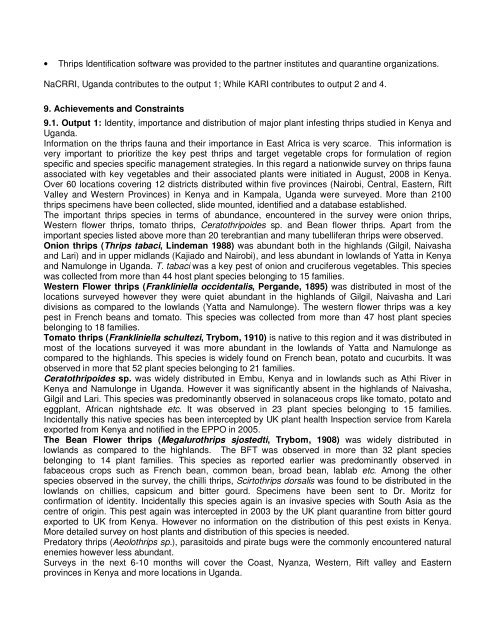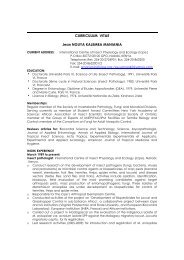Integrated control of thrips in vegetables in eastern Africa - icipe
Integrated control of thrips in vegetables in eastern Africa - icipe
Integrated control of thrips in vegetables in eastern Africa - icipe
Create successful ePaper yourself
Turn your PDF publications into a flip-book with our unique Google optimized e-Paper software.
• Thrips Identification s<strong>of</strong>tware was provided to the partner <strong>in</strong>stitutes and quarant<strong>in</strong>e organizations.<br />
NaCRRI, Uganda contributes to the output 1; While KARI contributes to output 2 and 4.<br />
9. Achievements and Constra<strong>in</strong>ts<br />
9.1. Output 1: Identity, importance and distribution <strong>of</strong> major plant <strong>in</strong>fest<strong>in</strong>g <strong>thrips</strong> studied <strong>in</strong> Kenya and<br />
Uganda.<br />
Information on the <strong>thrips</strong> fauna and their importance <strong>in</strong> East <strong>Africa</strong> is very scarce. This <strong>in</strong>formation is<br />
very important to prioritize the key pest <strong>thrips</strong> and target vegetable crops for formulation <strong>of</strong> region<br />
specific and species specific management strategies. In this regard a nationwide survey on <strong>thrips</strong> fauna<br />
associated with key <strong>vegetables</strong> and their associated plants were <strong>in</strong>itiated <strong>in</strong> August, 2008 <strong>in</strong> Kenya.<br />
Over 60 locations cover<strong>in</strong>g 12 districts distributed with<strong>in</strong> five prov<strong>in</strong>ces (Nairobi, Central, Eastern, Rift<br />
Valley and Western Prov<strong>in</strong>ces) <strong>in</strong> Kenya and <strong>in</strong> Kampala, Uganda were surveyed. More than 2100<br />
<strong>thrips</strong> specimens have been collected, slide mounted, identified and a database established.<br />
The important <strong>thrips</strong> species <strong>in</strong> terms <strong>of</strong> abundance, encountered <strong>in</strong> the survey were onion <strong>thrips</strong>,<br />
Western flower <strong>thrips</strong>, tomato <strong>thrips</strong>, Ceratothripoides sp. and Bean flower <strong>thrips</strong>. Apart from the<br />
important species listed above more than 20 terebrantian and many tubelliferan <strong>thrips</strong> were observed.<br />
Onion <strong>thrips</strong> (Thrips tabaci, L<strong>in</strong>deman 1988) was abundant both <strong>in</strong> the highlands (Gilgil, Naivasha<br />
and Lari) and <strong>in</strong> upper midlands (Kajiado and Nairobi), and less abundant <strong>in</strong> lowlands <strong>of</strong> Yatta <strong>in</strong> Kenya<br />
and Namulonge <strong>in</strong> Uganda. T. tabaci was a key pest <strong>of</strong> onion and cruciferous <strong>vegetables</strong>. This species<br />
was collected from more than 44 host plant species belong<strong>in</strong>g to 15 families.<br />
Western Flower <strong>thrips</strong> (Frankl<strong>in</strong>iella occidentalis, Pergande, 1895) was distributed <strong>in</strong> most <strong>of</strong> the<br />
locations surveyed however they were quiet abundant <strong>in</strong> the highlands <strong>of</strong> Gilgil, Naivasha and Lari<br />
divisions as compared to the lowlands (Yatta and Namulonge). The western flower <strong>thrips</strong> was a key<br />
pest <strong>in</strong> French beans and tomato. This species was collected from more than 47 host plant species<br />
belong<strong>in</strong>g to 18 families.<br />
Tomato <strong>thrips</strong> (Frankl<strong>in</strong>iella schultezi, Trybom, 1910) is native to this region and it was distributed <strong>in</strong><br />
most <strong>of</strong> the locations surveyed it was more abundant <strong>in</strong> the lowlands <strong>of</strong> Yatta and Namulonge as<br />
compared to the highlands. This species is widely found on French bean, potato and cucurbits. It was<br />
observed <strong>in</strong> more that 52 plant species belong<strong>in</strong>g to 21 families.<br />
Ceratothripoides sp. was widely distributed <strong>in</strong> Embu, Kenya and <strong>in</strong> lowlands such as Athi River <strong>in</strong><br />
Kenya and Namulonge <strong>in</strong> Uganda. However it was significantly absent <strong>in</strong> the highlands <strong>of</strong> Naivasha,<br />
Gilgil and Lari. This species was predom<strong>in</strong>antly observed <strong>in</strong> solanaceous crops like tomato, potato and<br />
eggplant, <strong>Africa</strong>n nightshade etc. It was observed <strong>in</strong> 23 plant species belong<strong>in</strong>g to 15 families.<br />
Incidentally this native species has been <strong>in</strong>tercepted by UK plant health Inspection service from Karela<br />
exported from Kenya and notified <strong>in</strong> the EPPO <strong>in</strong> 2005.<br />
The Bean Flower <strong>thrips</strong> (Megaluro<strong>thrips</strong> sjostedti, Trybom, 1908) was widely distributed <strong>in</strong><br />
lowlands as compared to the highlands. The BFT was observed <strong>in</strong> more than 32 plant species<br />
belong<strong>in</strong>g to 14 plant families. This species as reported earlier was predom<strong>in</strong>antly observed <strong>in</strong><br />
fabaceous crops such as French bean, common bean, broad bean, lablab etc. Among the other<br />
species observed <strong>in</strong> the survey, the chilli <strong>thrips</strong>, Scirto<strong>thrips</strong> dorsalis was found to be distributed <strong>in</strong> the<br />
lowlands on chillies, capsicum and bitter gourd. Specimens have been sent to Dr. Moritz for<br />
confirmation <strong>of</strong> identity. Incidentally this species aga<strong>in</strong> is an <strong>in</strong>vasive species with South Asia as the<br />
centre <strong>of</strong> orig<strong>in</strong>. This pest aga<strong>in</strong> was <strong>in</strong>tercepted <strong>in</strong> 2003 by the UK plant quarant<strong>in</strong>e from bitter gourd<br />
exported to UK from Kenya. However no <strong>in</strong>formation on the distribution <strong>of</strong> this pest exists <strong>in</strong> Kenya.<br />
More detailed survey on host plants and distribution <strong>of</strong> this species is needed.<br />
Predatory <strong>thrips</strong> (Aeolo<strong>thrips</strong> sp.), parasitoids and pirate bugs were the commonly encountered natural<br />
enemies however less abundant.<br />
Surveys <strong>in</strong> the next 6-10 months will cover the Coast, Nyanza, Western, Rift valley and Eastern<br />
prov<strong>in</strong>ces <strong>in</strong> Kenya and more locations <strong>in</strong> Uganda.







